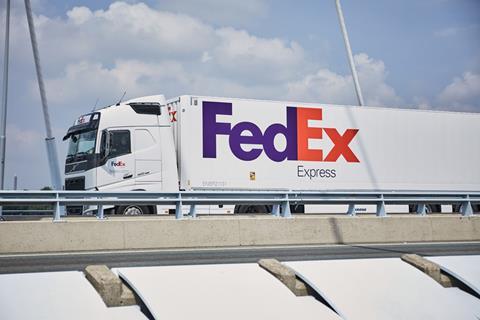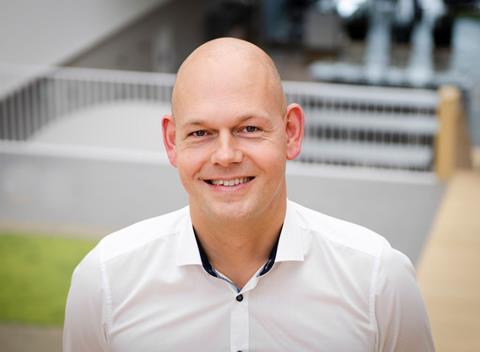Martin Gussinklo, senior vice president of the European road network, FedEx Express Europe, answers questions from MT.

What did the TNT integration mean for FedEx? Has the acquisition of TNT boosted your European operations? What does the integrated TNT/FedEx European road network look like in terms of hubs, depots, fleet and staff?
Our acquisition of TNT in 2016 gave us instant scale and scope as a top tier player in Europe, and most significantly, an unparalleled road network with the unique ability to ship both parcels and freight with a single interface to the customer. It gave our global customers access to Europe, and European businesses access to the world.
We now have a road network that’s one of the largest and fastest in Europe, connecting 45 countries, compromising more than 5,400 FedEx-owned trucks and trailers, and with a total of 50,000 weekly international linehaul movements across 28 road hubs.
How are European road network volumes looking for 2024 as the economy slows?
Economic headwinds are predicted to persist through 2024, with moderate growth for Europe. But these tighter economic conditions underline the importance of having a network that allows businesses to move goods reliably at a variety of price points. Customers who need urgent, express transportation will opt for air transport, but those who can make the time tradeoff are making a modal shift to our road network, which is one of the largest and fastest in Europe, with very competitive transit times.
Have there been any recent investments in the road network, outside of the TNT acquisition?
Yes, in 2023, we invested €125m in our road hubs in Duiven in the Netherlands and Novara in Italy, which has significantly increased capacity and improved working conditions for our team members. Duiven was reopened last April, following a two-year revamp, and we opened Novara in May last year. These hubs are now the largest and most technologically advanced in our European road network, featuring new state-of-the-art facilities to improve our capabilities, while leaving room for future growth.
In Duiven, a new 260,000sq ft hub sits on a 36-acre site and features a sorter, able to process approximately 200,000 parcels per day, as well as a separate freight handling area. With an increase in overall capacity of more than three times compared to the previous road hub, it also features more dock doors and improved yard operations, including new gates for quicker entry and a 20% increase in the trailer parking area.
The new Novara hub is located on a 52-acre site, with the hub occupying 345,000sq ft, divided into two main buildings for separate processing of freight and parcels, equipped with 240 truck docks. The parcel sorter has a total conveyor belt length of 3.73km and an initial capacity to process 21,600 packages and 8,000 small parcels and documents per hour. The freight building is equipped to handle 4,000 shipments of heavy or bulky goods per hour.
I buy a lot of stuff online and get parcels from most carriers like Royal Mail, Evri, DPD, DHL and Amazon – but rarely from FedEx. What is FedEx’s core target market in Europe – B2B or B2C?
We cater for both B2B and B2C. During the pandemic, but starting well before that, we saw a noticeable balance shift towards more B2C in Europe, and we’ve been adjusting our air, road and last mile networks accordingly. In addition, we’ve been adding to our e-commerce capabilities, including convenient delivery options to redirect parcels to 40,000-plus out-of-home locations across Europe, providing an estimated delivery time-window, and introducing the availability of picture proof of delivery for residential deliveries that do not require a signature.

As ecommerce continues to drive growth in the market, we are well positioned from an end-to-end perspective to serve both B2B and B2C through the portfolio of services we offer, from parcels to freight.
The European parcels market is highly competitive as Yodel’s difficulties show – what is the secret to making a profit from parcels?
Building a network that caters for parcels in a profitable way, takes time. Especially one that is resilient and highly flexible to fast changing external conditions. FedEx began operations in 1973 with 389 team members delivering 186 packages on the first day. Today, we have a team of more than 500,000 people across the world, moving around 15m packages every business day. The size and scale of our network allows us to adapt and be flexible to offer our customers the services they need, at a variety of speeds and cost-points.
To stay ahead requires a continuous focus on innovations and in the world of today that means adopting leading-edge technology as well as continuously adapting our network and understanding the capacity of the network given our customer’s product mix. Our recent investments have future-proofed our road network in Europe, to aid long-term profitable growth.
How much of FedEx’s European volume is transported via road, compared to air?
The volume split depends on the service customers choose, with 95% of our customers shipping a mix of premium, standard and deferred volumes, so we flex how we ship goods to their doors based on the desired lead times. Having a combined road and air network means we can offer one-stop shopping for parcels and freight with a single interface to the customer.
How have your recent investments in the road network – Duiven and Novara, benefited the wider region?
Both of our new hubs are strategically positioned within the ‘blue banana’, a large corridor of urbanisation and economic prosperity stretching from North West England to Northern Italy. Novara now serves as a gateway between Italy and major markets throughout Europe, connecting customers in this region to countries across Europe. In addition, it’s also benefiting the local area and communities, with more than 450 jobs.
Duiven features a new sorter which can process approximately 200,000 parcels a day, which is more than three times the capacity of the previous road hub with room for future growth. One of the indirect advantages of this upgrade is a recent value proposition improvement for our customers in the Benelux, where we are now able to offer a lower cost for next day delivery for domestic and intra-Benelux shipments.
Our wider network optimisation developments, including these two hubs, is key to regional job creation, and has led to direct economic growth in the respective markets - over $3bn (£2.36bn) in economic output for Europe in our fiscal year 2021/22 (to May 2022).
What is FedEx doing to decarbonise its business across the road network? What will a truly sustainable logistics business look like in say 10 years’ time?
We operate in one of the more challenging sectors when it comes to decarbonisation, especially for linehaul operations. Battery technology, for instance, is more readily available for last mile transportation using light commercial vehicles.
In linehaul, we continue to test new vehicle types at different weight classes from 19 tonnes to 40-tonne tractor-trailer combinations. While battery range and charging infrastructure to operate these vehicles cross border is still lacking, we are introducing renewable diesel where possible in pilots in the Netherlands and the UK. Last autumn, we began trialling hydrotreated vegetable oil (HVO) renewable diesel in our truck fleet in the UK. This fuel avoids the use of fossil fuel sources, so while the vehicle does still produce emissions, the overall lifecycle emissions are significantly less. We see this as an important bridging solution for linehaul. It’s attractive because it is available now, and can be used in our existing fleet.
We recognise though, that there is not one single solution to decarbonisation. This February, we started trialing a hydrogen-powered vehicle in our last-mile delivery operations in Utrecht in the Netherlands, which is a Europe first for us and an exciting milestone.
Over the next 10 years we expect to see these technologies and their associated infrastructure mature. We will continue to collaborate with all stakeholders involved, including governments and vehicle manufacturers, as it will take all of us working together to develop the solutions we need for the environment while keeping trade flowing in Europe and around the world.
Are there any other fleet modernisation or efficiency optimisation plans in the pipeline to boost your European service for customers?
We’ve made considerable investments in our hubs and physical network in the past 12 to 18 months. A key focus now is on finding new ways, through predictive analytics and other technologies, to make sure we operate that physical network in the most efficient, reliable way.
All of our own trailers for instance, are equipped with solar panel-powered GPS devices to track our movements across Europe. This not only enhances security for our customer’s shipments, it also allows us to maximize the planning of these movements. In addition, we are now connecting these data to data from other sources to maximize their value and put them to work in different ways.
We launched an application allowing us to have a full view on what’s being transported in the trailers we operate across our network. This means our sorting locations (the road hubs) can maximize their resource and capacity planning because they can see what’s coming their way and how it is loaded. As the data and decisions based on the data continue to build in the system, it ‘learns’ and provides suggestions/predictions for the actions to take.
Do you have any other bold plans or predictions for the remainder of 2024?
In 2024 we’ll continue to see the deployment of predictive analytics and other technologies to improve real-time visibility and resilience of supply chains.
At FedEx, the size and scale of our physical network and the millions of packages that traverse it every day gives us a bird’s eye view of global supply chains and trends. We have around 15 million packages in our network daily. Each one is scanned 20 to 25 times – that is a lot of data.
To make this data work for our customers, we launched FedEx Surround, a dashboard using AI and machine learning to calculate the risk of shipments arriving late in near real time. Using the package fingerprint, scan information and predicted weather conditions, FedEx Surround highlights delivery risks, comparing it to millions of previous shipments during recent months.
In 2024, we continue to embed this technology into our business in Europe.















